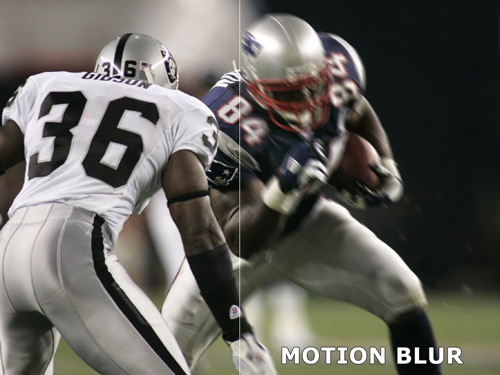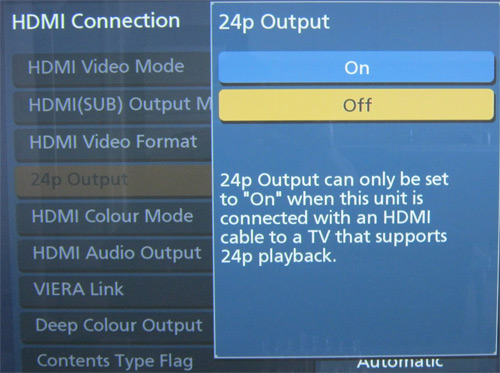A Guide to HDTVs
[Page 9] Motion Handling
As we briefly covered in the Video Basics section of this guide, the standard for most video is 50Hz or 60Hz, which usually translates to 50 or 60 frames per second respectively on a progressive scan HDTV. Taking 60 FPS as an example, this means that every second an HDTV shows 60 frames of video to form a moving image. This equates to a new frame of video being displayed every 16.67 milliseconds (ms), where 1,000ms = 1 second. The way in which they handle motion is a point of major difference between LCD and plasma TVs. When handled inadequately, you will experience issues such as motion blur, smearing, judder, phosphor trails or input lag.

On an LCD-based display, the total time taken for a pixel to change from black to white to black again is called the Response Time and is measured in milliseconds. The type of backlight used is not relevant to this process, since the measure is of the time taken for the liquid crystals to twist. Most modern LCD TVs advertise response times of 4 ms (120Hz models) or 2 ms (240Hz models), and in more recent cases, even as low as 1 ms (480Hz models).
On a phosphor-based screen, such as a traditional CRT TV or a plasma TV, the response time is effectively well under 1ms, with the latest plasmas having pixel response times which are near-instantaneous (around 0.001 ms). This is because once a phosphor is lit up, it can be instantly switched off again. One of the reasons for this rapid response time is that Plasma cells are in a constant state of pre-charge. This rapid response time is also where the marketing term 600Hz Sub Field Drive comes from. It means that for 60 frames per second of video, the plasma uses Pulse Width Modulation to control the power to the phosphors, pulsing them at 10 times per frame to maintain a bright image - 10 pulses per frame x 60 FPS = 600Hz. This does not equal 600 frames per second though, it is simply 60 FPS with 10 flashes per frame. See the Brightness, Black Level & Contrast Ratio section for more details of plasma pre-charging and Pulse Width Modulation.
In theory, since only a 16.67 ms response time is needed for 60 FPS video, both the faster LCDs (4 ms or less response time) and any plasma TV (less than 1 ms response time) should be able to easily reproduce motion without any issues whatsoever, right? Wrong. There are issues inherent to both the technologies as well as the source material involved which prevent this.
LCD TV manufacturers often quote response times which measure the time taken to switch between two arbitrary colors, such as two tones of grey, or whichever other color transition is the fastest, rather than the correct but slower black-white-black time. This means the response time measure they provide in their technical specifications represents the optimal speed with which certain transitions occur, not the average or worst possible speed. Even the fastest LCD TV with the lowest quoted response time may exhibit motion blurring or other motion artifacts at times simply because the crystals can't change fast enough through certain transitions.
While plasmas are extremely fast and don't have any such issues with response time, there are two potential drawbacks of plasma's phosphor-based technology. The first is that a plasma pixel isn't constantly lit up the way an LCD pixel is, and these "gaps" in the image when a phosphor momentarily loses its brightness, however small, can result in some people perceiving a form of flickering, especially on brighter backgrounds. The second issue is a result of the way in which phosphor-based colors are mixed in a pixel and then certain portions of those colors fade away more rapidly than others leaving a typically green or yellow trail behind a moving object on the plasma screen. More details, including ways of reducing these phosphor trails, are in this article. In practice the majority of people do not really notice any flickering or phosphor trailing, especially as newer 3D-capable plasma TVs also have faster phosphors. However a small proportion of people find one or both of these issues very noticeable and quite annoying, so it is something to look out for on plasmas.
The heart of the motion handling issue lies in the way our eyes perceive images. Due to a property of the human eye known as Persistence of Vision, we retain a brief afterimage of what we've seen for around 10 ms or more after it's disappeared. While watching a plasma this doesn't cause any problems; the phosphors can be turned on and off almost instantaneously, and they do not retain an image (afterglow) for more than 1 ms at the most. In fact as a plasma pixel momentarily goes dark between refreshes, our persistence of vision helps to smooth things out by retaining the image to help fill in that gap. On an LCD, the afterimage in our eyes can cause issues: the LCD pixels can't change quite as quickly, and they remain a particular color until they change - they usually don't blank out or switch off between frames. The result is that on an LCD, the persistent image in our eyes can actually clash with the residual image on the screen, and there is greater chance for perceived motion blurring if there is even the slightest difference between these two.

The screenshot above is split into two portions: the left side shows ideal motion handling, while the right side simulates the motion blur which can occur if motion is handled poorly.
Manufacturers are well aware of the inherent motion handling drawbacks of LCD panels, and as response times have dropped, they have introduced various techniques to increase the refresh rate and reduce image persistence problems on LCDs. This is why 120Hz and 240Hz LCDs are becoming more common. One or more of the following techniques may be implemented on a particular LCD TV to achieve higher refresh rates and/or frame rates and thus achieve smoother motion:
While these techniques can noticeably improve the appearance of motion on LCDs, they can also introduce artifacts to the image. Motion interpolation in particular can make motion appear unnaturally smooth, earning the nickname "Soap Opera Effect" in reference to the fact that it makes cinematic content look like it's been shot on the video cameras used to make daytime soap operas. Fortunately, motion interpolation can usually be turned on or off as desired.
Motion handling is most important when viewing fast action content, such as sport or action movies. If your viewing consists of a significant amount of these types of sources, then you should consider plasma over LCD, since despite improvements, plasma's motion handling is superior and more natural to the eye than LCD.
Pulldown Judder and 24p
One aspect of motion handling which can occur on any display technology is loosely known as Judder. We discussed the pulldown conversion process in the Video Basics section of this guide - converting 24 FPS movie material into the 60Hz-based NTSC standard for video playback will result in some framerate unevenness known as judder: a slight jerkiness which is particularly visible as the camera pans around. It occurs on both plasma and LCD, because it's independent of the way the screen refreshes itself.

For those who don't like pulldown judder, playing back movies at their original unaltered framerate is possible. This Native 24p option must be explicitly supported by both your HDTV and Blu-ray player, so check the technical specifications of both. Since DVDs and Blu-rays are typically encoded with 24 FPS (24p) movies, and if your TV and player support it, native 24p allows you to see movies without any frame rate alteration through pulldown. The downside is that 24 FPS is not a particularly high frame rate, which is why various methods of converting the frame rate to the higher 50Hz or 60Hz standards were implemented in the first place. The native 24p content will have noticeable motion judder/frame break-up during fast camera pans. It may also have additional flickering, depending on the refresh rate at which your TV handles native 24p content. Whether plasma or LCD, some TVs will flash each frame multiple times to create a higher refresh rate in multiples of 24, such as 48Hz, 72Hz, 96Hz or 120Hz. A higher refresh rate will reduce flickering but because the source is still playing back at 24 FPS (as intended), motion problems due to low frame rate will always be there. Some HDTVs also add the option of motion interpolation in native 24p playback, which will smooth out this motion judder. In some ways this defeats the purpose of watching native 24p, since the original 24 frames per second are now being altered through artificially generated frames inserted into the video, and once again, Soap Opera Effect may be noticeable.
In terms of settings, your choice essentially comes down to which of the three common forms of source motion issues you prefer: pulldown judder, 24p judder, or the artificial smoothness of motion interpolation. Because pulldown has been used for so long on TV, most people have become used to it and don't really notice it. Furthermore, pulldown judder also provides a mild form of motion blurring which covers up 24p judder. See this article for a more detailed explanation of why pulldown judder may actually be preferable to native 24p judder.
Input Lag
For anyone who wishes to use their HDTV as a display monitor for a gaming console such as an X-Box 360 or PlayStation 3, or for PC gaming, then an additional factor needs to be considered: Input Lag. This manifests itself in the form of a slight delay between pressing a button on your controller or keyboard, and the resulting action within the game on the screen. It's most noticeable in fast-paced action games or games where precise timing is absolutely critical.
Despite the extremely fast response times of plasma TVs, and the increasingly faster response times of LCD TVs, input lag can still occur on all types of HDTVs, moreso than LCD computer monitors. This is because the video image on an HDTV typically undergoes various transformations to improve its appearance. This image processing can include rescaling the image, removing jagged edges, reducing the noise, adjusting the motion, sharpening the picture and enhancing the colors. All of these add some form of delay to the display of the image. Some of these image processing options can be disabled in the display options - see the Calibration section for details. Most recent HDTVs also come with a specific Game mode designed to reduce input lag by automatically disabling as much of the unnecessary image processing as possible; it may noticeably reduce image quality but it will also reduce any input lag.
There is no easy way to accurately measure and compare the input lag on a display, particularly as input lag can be as little as 30 ms or less (i.e. 30/1000ths of a second). There are various tools for measuring this input lag, including: this Input Lag Test, this Online Monitor Test and the Human Benchmark. The best method is to actually try a display out before purchasing it, but a close second-best is to read various reviews and user feedback, as these should tell you the degree to which input lag is actually noticeable on a particular TV.
For a more detailed look at input lag, see this article. In general plasmas will have lower input lag than LCDs due to their much faster response time.
